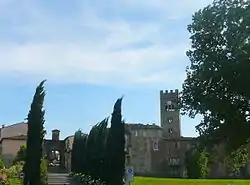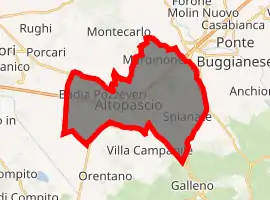Altopascio
Altopascio is a comune in the Province of Lucca in the Tuscany region of Italy with a population of 15,572.
Altopascio | |
|---|---|
 Church of San Jacopo Maggiore. | |
Location of Altopascio 
| |
 Altopascio Location of Altopascio in Italy  Altopascio Altopascio (Tuscany) | |
| Coordinates: 43°49′N 10°41′E | |
| Country | Italy |
| Region | Tuscany |
| Province | Lucca (LU) |
| Frazioni | Badia Pozzeveri, Marginone, Spianate |
| Government | |
| • Mayor | Sara D'Ambrosio |
| Area | |
| • Total | 28 km2 (11 sq mi) |
| Elevation | 19 m (62 ft) |
| Population (31 December 2017)[2] | |
| • Total | 15,572 |
| • Density | 560/km2 (1,400/sq mi) |
| Demonym(s) | Altopascesi |
| Time zone | UTC+1 (CET) |
| • Summer (DST) | UTC+2 (CEST) |
| Postal code | 55011 |
| Dialing code | 0583 |
| Patron saint | St. Jacopo |
| Saint day | July 25 |
History
Already inhabited in Roman times, Altopascio gained in importance due to its Spedale (hostel, first mentioned in 1084) for the pilgrims who travelled on the Via Francigena, leading from France to Rome. This formed the basis of the later Order of Saint James of Altopascio. This, founded by Matilda of Canossa between 1070 and 1080, was one of the first of the Military Orders; it existed for four hundred years, in which it had considerable social, political and military influence, and though gaining land in various European countries retained its strong ties to the town where it was founded.
It is famous for the battle of Altopascio in 1325 in which the Ghibelline leader Castruccio Castracani defeated the Florentines Guelphs led by Ramon de Cardona. Thanks to his victory, he became duke of Lucca.
The Spedale declined starting from the 16th century, until Grand Duke Peter Leopold suppressed it in 1773, to favour that in Pescia.
Main sights
- Badia of St. Peter, known from 1039. It was held by the Benedictines from 1086 and then by the Camaldolese from 1103. It reached its maximum splendour in the later 13th century, but by the Battle of Altopascio (1325) it began to decline, and was abandoned in 1408. Of the medieval original structure, only the exterior of the apse remain.
- Church of Santi Jacopo, Cristoforo and Eligio (best known as San Jacopo Maggiore), annexed to the Spedale. It was a medieval hospital complex, of which the cloister, the bell tower and parts (façade and apse area) of the Romanesque church.
Twin towns
 El Perelló, Spain
El Perelló, Spain Saint-Gilles, France
Saint-Gilles, France
References
- "Superficie di Comuni Province e Regioni italiane al 9 ottobre 2011". Istat. Retrieved 16 March 2019.
- "Popolazione Residente al 1° Gennaio 2018". Istat. Retrieved 16 March 2019.
